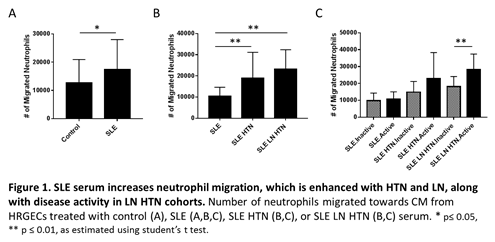Session Information
Date: Sunday, October 21, 2018
Title: Systemic Lupus Erythematosus – Etiology and Pathogenesis Poster I
Session Type: ACR Poster Session A
Session Time: 9:00AM-11:00AM
Title: Lupus Nephritis Serum Induces Neutrophil Chemotaxis towards Glomerular Endothelial Cells In Vitro
Background/Purpose: Systemic lupus erythematosus (SLE) is a chronic inflammatory disease associated with endothelial cell dysfunction (ECD), a key modulator of proliferative renal disease through upregulation of adhesion molecules, release of inflammatory chemokines, and ingress of neutrophils into glomerular tissue. Understanding how ECD processes lead to neutrophil influx across the endothelium is essential to finding therapeutic targets for SLE. Our previous studies showed that lupus serum induces neutrophil adhesion to glomerular endothelial cells. The aim of this study is to uncover the functional ability of SLE serum from patients with active disease to induce chemotaxis of neutrophils towards glomerular endothelial cells.
Methods: SLE patients meeting ACR criteria had serum collected and stored at -80˚C during paired visits with lower and higher activity by SLE Disease Activity Index (SLEDAI) score. 15 SLE patients (5 SLE only, 5 SLE with hypertension (HTN), and 5 SLE lupus nephritis (LN) with HTN) and 10 healthy controls (5 with and 5 without HTN) were examined. To assess the functional ability of SLE serum to induce neutrophil chemotaxis, primary Human Renal Glomerular Endothelial Cells (HRGECs) were cultured in 10% SLE serum (or control serum) for 3 hours and washed, then conditioned media (CM) was collected. Neutrophils collected from healthy donors and stained with Calcein AM were then allowed to migrate through a transwell towards the CM for 1 hour. Migration towards CM was calculated as cells that migrated into the receiving wells based on fluorescence intensity. Groups were compared using student’s test.
Results: SLEDAI scores from lower and higher activity paired visits were 0-6 and 4-14 (always ≥ 4 points higher than the inactive visit). HRGECs treated with SLE serum and HTN serum (SLE and control aggregated) induced significantly greater neutrophil chemotaxis than control serum (p=0.027) (Figure 1A) and non-HTN serum (not shown, p=1.8 x 10-7), respectively. HRGECs treated with SLE HTN serum and SLE LN HTN serum significantly promoted neutrophil migration compared to SLE serum (Figure 1B, p= 0.0007, p= 4.173E-09) with only SLE LN HTN showing significant differences between inactive and active disease (Figure 1C, p= 0.001).
Conclusion: This study suggests that circulating factors in SLE serum induce expression of mediators by glomerular endothelial cells that promote neutrophil migration, furthering our understanding of how ECD processes lead to renal inflammation in SLE. Furthermore, hypertension may be an independent and synergistic mediator of ECD induced by circulating factors in SLE.
To cite this abstract in AMA style:
Russell D, Markiewicz M, Zhang X, Oates JC. Lupus Nephritis Serum Induces Neutrophil Chemotaxis Towards Glomerular Endothelial Cells in Vitro [abstract]. Arthritis Rheumatol. 2018; 70 (suppl 9). https://acrabstracts.org/abstract/lupus-nephritis-serum-induces-neutrophil-chemotaxis-towards-glomerular-endothelial-cells-in-vitro/. Accessed .« Back to 2018 ACR/ARHP Annual Meeting
ACR Meeting Abstracts - https://acrabstracts.org/abstract/lupus-nephritis-serum-induces-neutrophil-chemotaxis-towards-glomerular-endothelial-cells-in-vitro/

